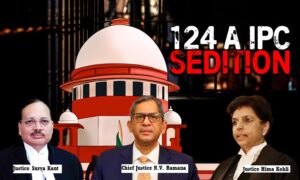A law that deserves death

– Ranen Kumar Goswami-
A renowned Guwahati-based journalist.
Room for imaginary and convenient interpretation in a law to manufacture fear can be disastrous for a citizen’s life. Section 124A of the Indian Penal Code has enough of it. Frequently at its receiving end and languishing in jails for years on end as a result, the dissenters know its real taste. Back in July 15, 2021, the Supreme Court asked the Centre’s views on whether the British-era sedition provision Section 124A, used to punish freedom fighters like Mahatma Gandhi and Bal Gangadhar Tilak to quell dissent and protest, should be retained even when there is continued evidence of its misuse by police without any accountability.
A Bench, comprising Chief Justice N.V. Ramana and Justices A. S. Bopanna and Hrishikesh Roy, said it was of the opinion that the sedition law should be used only for protection of the nation, its security and institutions of importance in a democracy.

However, the Bench said, the law, enacted by the British to subjugate the people of India, had been grossly misused much in a similar way to suppress dissent…………. “It is like giving a saw to the carpenter to cut a piece of wood for making furniture. If he uses it to cut the entire forest, imagine the devastating impact.”

Section 124A says: “Whoever, by words, either spoken or written, or by signs, or by visible representation, or otherwise, brings or attempts to bring into hatred or contempt, or excites or attempts to excite disaffection towards the Government established by law in (India), shall be punished with imprisonment for life, to which fine may be added, or with imprisonment which may extend to three years, to which fine may be added or with fine.”
In Explanation 1, the Section says: “The expression ‘disaffection’ includes disloyalty and all feelings of enmity. “

Thomas Babington Macaulay
The IPC was the brainchild of Thomas Babington Macaulay, who chaired the then Law Commission. It came into force from the year 1860. Sedition was included as an offence under Section 124A in 1890.
The punishment prescribed then was “transportation beyond the seas for the term of his or her natural life”.It was amended to life imprisonment in 1955. One of the most notable trials under this Section, Queen Empress versus Bal Gangadhar Tilak, took place in 1898.
In post-Independence India, in several legal disputes, prompted by the sedition law, various levels of the judiciary recorded their observations, mostly negative, about the law.
A notable one among them was the Kedarnath Singh Versus State of Bihar in 1962. Even though in this case, a five-judge Constitution Bench of the Supreme Court upheld the constitutional validity of IPC Section 124A, the court wanted to restrict its scope for misuse. The court said that unless accompanied by an incitement or call for violence, criticism of the Government cannot be labeled sedition. The ruling restricted sedition only in so far as seditious speech with an objective to incite “public disorder”.
Issuing guidelines on using the sedition law, the court said that not all speech with “disaffection”, “hatred “or “contempt” against the State, but only speech that is likely to incite “public disorder” would qualify as sedition.
Let’s recall here how ambiguous the Centre’s reply was to a question in Lok Sabha on March 16, 2021 as to whether the Government proposed to scrap the present provisions of sedition in IPC. The then Minister of State for Home, G. Kishan Reddy said: “Amendment of criminal law is a continuous process.”
Now let’s pay a glance at the National Crime Records Bureau (NCRB) data.
Altogether 356 cases of sedition were registered and 548 persons arrested between 2015 and 2020. However, just 12 persons held in seven sedition cases were convicted in this six-year period. As many as 73 persons were arrested under Section 124A in 2015, 48 in 2016, 228 in 2017, 56 in 2018, 99 in 2019 and 44 in 2020. Total cases registered under the law were 30 in 2015, 35 in 2016, 51 in 2017, 70 in 2018, 93 in 2019 and 73 in 2020.
In contrast, the rate of conviction was zero in 2015, 33.3% in 2016, 16.7% in 2017, 15.4% in 2018, 3.33% in 2019 and 33.3% in 2020. In 2018-2020, Assam recorded the highest arrests for sedition with 23 each in 2018 and 2019 and 10 in 2020. In 2020, Manipur had the highest number of sedition cases at 15, followed by Assam with 12, Karnataka with eight and Uttar Pradesh with seven cases.
The Centre, in a written submission `by solicitor general Tushar Mehta on May 07, 2022, contended in the Supreme Court, which is now hearing a bunch of petitions challenging the constitutional validity of the colonial-era law, that the apex court’s six-decade old verdict in Kedar Nath Singh case needed no
re-examination.
Defending Section 124A, the Centre said the sedition law has withstood the test of time. But in a U-turn two days later on May 09, 2022, the Centre told the court that in deference to Prime Minster Narendra Modi’s views, the Government will go in for a comprehensive reconsideration of Section 124A for necessary pruning and provisioning of safeguards to curb its misuse and requested the court to defer scrutiny of the sedition provision.
And on May 11, 2022, in an unprecedented order, the Supreme Court virtually suspended operation of the much-abused sedition provision to prevent police from invoking it against anyone from now on and stayed both probe and trial in existing sedition cases to allow the Centre to re-examine Section 124A to sync it with the present social milieu.

The Bench, comprising Chief Justice N.V. Ramana, Justices Surya Kant and Hima Kohli, reportedly drafted its order in 30 minutes of it being reserved. It said: “We hope and expect that the State and Central Governments will restrain from registering any FIR, continuing any investigation or taking any corrective measures by invoking Section 124A of the IPC, while the aforesaid provision of law is under consideration.”
Hailing the order in its editorial on May 13, 2022, titled, “Momentous judgement”, The Assam Tribune has called the sedition law a “contradicting anachronism in independent, democratic India…….. Successive democratically-elected governments have weaponized it as a tool of suppression to be used against students, journalists, intellectuals, social activists and those critical of the government.” Advocating its total repeal, another leading daily of the country has expressed its apprehensions saying that even a changed sedition law will be misused.
In its editorial on May 12, 2022, the daily says: “There’s never been a better moment than now for consigning to history a law that goes back to the 19th century and that free India should have never had on its statues for so long. ……. Slogans and now tweets are chants are seen as enough for slapping a sedition case.”
We do agree that the draconian law deserves a death sentence.
Source: Assam Tribune (17-5-2022)
[* The writer is a renowned Guwahati-based journalist.]
News Mania’s journalists were not involved in the production of this article. The facts and opinions appearing in the article do not reflect the views of News Mania and it is completely personal data and opinion of the writer.)






